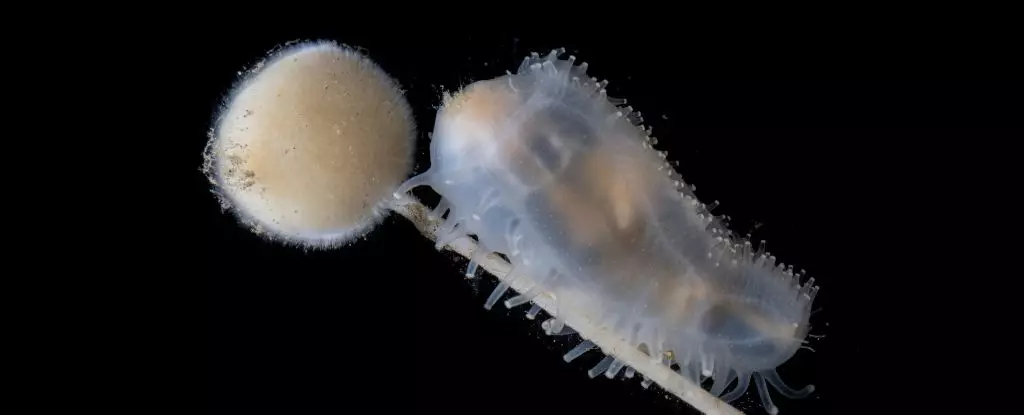In a remarkable journey that redefined our understanding of marine biodiversity, a recent expedition to one of Earth’s most inscrutable locales— the South Sandwich Islands—has illuminated the hidden treasures of the deep sea. Operated by the Schmidt Ocean Institute aboard the research vessel Falkor (too), this 35-day mission was part of the ambitious Ocean Census initiative aimed at cataloging marine life that is at grave risk due to climate change and resource exploitation. The expedition’s primary focus was the unexplored hydrothermal vent systems in the Southern Ocean, known for hosting complex ecosystems that thrive in extreme conditions.
Despite facing treacherous underwater earthquakes, relentless hurricane-force winds, and towering icy waves, the dedicated international team of scientists emerged from this challenge with astonishing footage and discoveries that will reshape marine biology. Among these discoveries, the vibrant ecosystems centering around hydrothermal vents are nothing short of mesmerizing, challenging the limits of our knowledge about life forms that exist in the dark, cold depths of the ocean.
Unprecedented Discoveries Along the Veins of the Earth
In a twist of fortune that science fiction authors might envy, the expedition unveiled a vermilion coral garden flourishing around Humpback Seamount. Situated at a staggering depth of 700 meters (nearly 2,300 feet), these coral formations exhibit colors and biodiversity that scientists had not anticipated, showcasing ecosystems so uniquely adapted that they beckon further investigation. Encircling the tallest vent chimney, which stands bravely at four meters (13 feet), marine creatures like barnacles and sea snails have found their habitat, drawing a comparison to the awe-inspiring cityscapes of urban dwellers above water.
One cannot help but marvel at the lively dance of shrimp that flit about these mineral-rich structures, captivating all who are fortunate enough to witness them. This particular expedition represents the first successful exploration of these hydrothermal vents using remotely operated vehicles (ROVs), paving the way for future missions to delve deeper into the secrets held by these mysterious underwater worlds. “Discovering these hydrothermal vents was a magical moment, as they have never been seen here before,” stated hydrographer Jenny Gales, implying that the excitement of such discoveries transcends mere academic interest and taps into our collective thirst for exploration.
Intriguing and Disturbing Encounters with Marine Life
Not every discovery was wrapped in beauty; some findings evoked a sense of discomfort. A notable example is a grenadier fish observed with parasitic copepods clinging to its gills like grotesque ornaments, a stark reminder of the ocean’s harsh realities. Similarly, the stout sea cucumber, recorded 650 meters below the surface, was found munching on an unidentified deep-sea puffball, illustrating the interconnectedness of life forms in this unexplored realm.
Among the most captivating visuals captured during the expedition was the first photograph of a dragonfish species, Akarotaxis aff. gouldae, long eluding researchers despite the attention of the scientific community. Such discoveries underscore the notion that the ocean is far from fully understood, and every exploration holds the potential to rewrite established knowledge.
The surprise element was not only in discovering new species but also in encountering snailfish eggs resting on black coral—an extraordinary finding that even seasoned marine biologists were unaware of. This expedition offered us a moment of reckoning, as it shed light on the mysteries that persist in our oceans and emphasized the urgency of studying these ecosystems before they are irrevocably harmed.
The Call to Action for Ocean Conservation
Marine biologist Michelle Taylor poignantly remarked, “This expedition has given us a glimpse into one of the most remote and biologically rich parts of our ocean. This is exactly why the Ocean Census exists—to accelerate our understanding of ocean life before it’s too late.” Her statement encapsulates a clarion call for scientists, policymakers, and ocean enthusiasts alike to consider the fragility of underwater ecosystems and the pressing need to safeguard them against advancing threats.
While our knowledge has expanded with these findings, one must ask what fate awaits such unexplored realms amid escalating human activities. The discoveries unearthed during this groundbreaking expedition represent not just a scientific triumph but a sobering reminder of our responsibility to protect the irreplaceable wonders of the deep sea. As we peer into the depths of this peculiar underwater universe, we stand at a crossroads, where exploration and conservation must go hand in hand.

